


CEO and President of FORUM8
Digital Minister of Taiwan
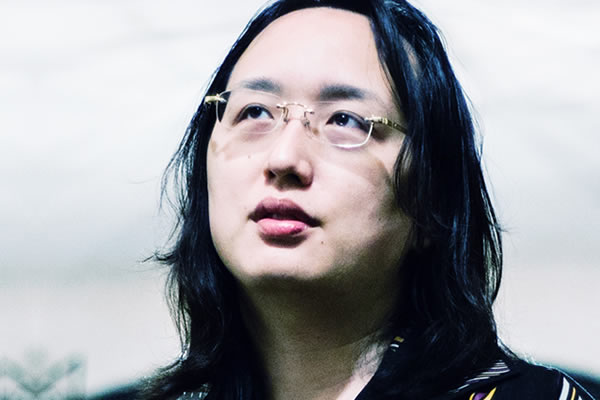
Lecture
Profile
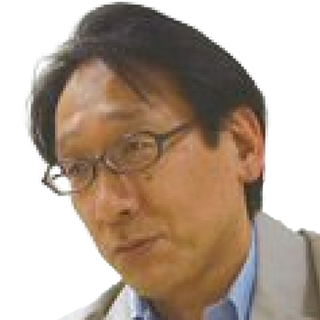
Tsunami Engineering Lab, Risk Evaluation and Disaster Mitigation Research Division, International Research Institute of Disaster Science, Tohoku University
Profile

Fire Safety Engineering Group (FSEG), The University of Greenwich
Profile

Construction IT Journalist
Profile
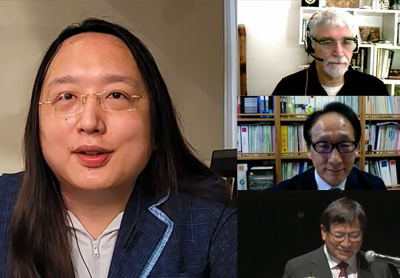
First of all, Minister Tang said that in the midst of the COVID19 pandemic, the digital social innovation continues to accelerate democracy in Taiwan, and deepen the collaboration across sectors. In order for the government to advance reforms not just for the people but also with the people, it is important to “trust our citizens”, otherwise it no trust can be gained. Therefore, it is important to introduce the technology into where the citizens are, rather than adapting the citizens to new technologies. Mentioning an example that the contact tracing system has been implemented through the proposal of a civic tech community, the Minister concluded that collaboration across different sectors would enable construction of resilient digital and social infrastructure.
Next, in line with the theme "How the government should prepare for disasters such as tsunamis?", Prof. Imamura mentioned the past experience of delayed evacuation in the Great East Japan Earthquake 10 years ago for the tsunami prediction of the first report of the tsunami warning system was underestimated. Then, he pointed out the trade-off relation; it is difficult to grasp the whole conditions with the information immediately after the occurrence of disaster, but as time passes, though information gets more accurate, people fail to evacuate in time.
Then, Prof. Galea stated that it is necessary to have a robust plan for natural disasters, including education and training for the general public, for which simulation plays a major role. He also stressed that as the local residents do not always act in the way engineers and government officials expect them to, simulations are created taking account of how they react to and act on natural disasters. He also explained the need to improve easy-to-understand disaster warnings and evacuation signs, and to have their meaning understood and spread among the people.
Through the discussion, the three panelists shared the importance of educating children about disaster prevention. Prof. Imamura introduced an example of elementary school students who had learned the lessons from the past tsunamis, supporting the early evacuation of local residents in the Great East Japan Earthquake. According to Digital Minister Audrey Tang, children in Taiwan learn about complex elements that affect air and water quality step by step, as well as learn disaster prevention and environment while having fun using participatory apps. It was reported that the young age group under 18 is most passionate about disaster prevention. Prof. Galea indicated that education of the children would lead to resilient society because children teach what they are taught to their parents and other adults. To conclude the discussion, Prof. Imamura proposed to share disaster communication by international standardization. Prof. Galea indicated that listening to what the general public say and incorporating their opinions into the disaster prevention plan would help the public prepare their mind for disaster, and Minister Tang said it is effective to share ideas through public-private partnerships.
Fire Safety Engineering Group (FSEG), The University of Greenwich
Lecture
Profile
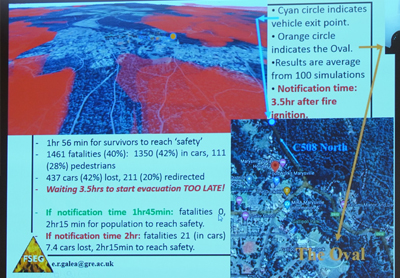
First of all, he introduced the organization and research contents of FSEG to which he belongs, and its development of the evacuation simulation "EXODUS" and the fire simulation "SMARTFIRE". Following this, he explained the following efforts. 1) Regarding movement assist devices for Persons with Reduced Mobility (PRM) who need support for evacuation during fires etc., simulation is performed with BuildingEXODUS using performance information of various devices obtained in the experiment. In addition, spatial and kinematic constraints, holonomic/non-holonomic devices, and spatial configurations are considered in the explicit modeling of physical devices. Optimal solutions have been developed that reflect the constraints of each device in complex spaces. 2) Based on the problems of conventional signs, the Active Dynamic Signage System (ADSS) developed through experiments and measurements and conventional signs are simulated using EXODUS. The effectiveness of ADSS is confirmed. 3) Experiments are conducted at actual sites to digitize a variety of issues of evacuation from high-rise building construction sites. The differences depending on the condition of the evacuation route or the presence or absence of hoists, such as reaction time and evacuation time are modeled. 4) urbanEXODUS developed for large-scale urban disasters is linked with various models. The evacuation of pedestrians and vehicles in the large-scale fire is simulated. 5) Using the recently developed matEXODUS, the influence of marauding armed terrorists (MAT) in crowded places is simulated. 6) In order to elucidate the mechanism of novel coronavirus infection on trains and while walking, SMARTFIRE is arranged to simulate aerosols. He mentioned the usefulness of advanced simulation tools such as EXODUS and SMARTFIRE in planning to ensure safe and secure evacuation or infection control.
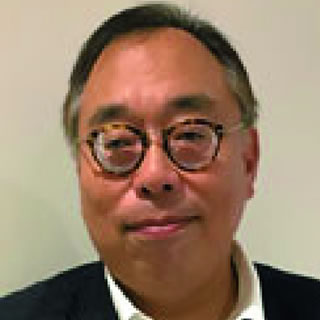
Executive director, Association for Resilience Japan

Lecture
About Association for Resilience Japan
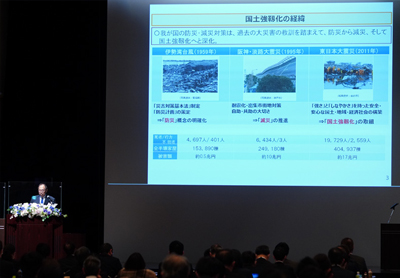
First of all, he mentioned the position of National Resilience in the Policy Speech of Prime Minister Fumio Kishida (October 2021) and other speeches, and “A Vision for a Digital Garden City Nation Realization” in Emergency proposal of the New Form of Capitalism Realization Headquarters (November 2021). Next, he summarized the history of how the traditional disaster prevention and mitigation measures based on the lessons learned from major disasters had been deepened and led to the concept of national resilience, frequent occurrence of natural disasters in recent years, the flow concerning Basic Act for National Resilience and the promotion system, large-scale natural disasters assumed as warning zones in terms of national resilience, and the possibility of their occurrence and damage. He outlined the importance of preliminary measures to reduce disaster risks for national resilience, the framework of promoting national resilience, the transition of the related budgets, the points of five-year acceleration measures with high weights, and the positioning of DX-related policies.
Then, he continued to develop his speech into the progress in the establishment of Association for Resilience Japan, which is responsible for promoting private-sector efforts for national resilience, its organizational structure, role and activities, and management of the resilience certificate systems, symposiums and awards as part of them (e.g. FORUM8 received "the first Minister in Charge of Building National Resilience Prize” of “the 7th Japan Resilience Award”), policy proposals by the working group, and reflection of them in the national resilience annual plan. Finally, he explained the contents of examination and the results at each meeting and study group related to DX held in 2021.

Leader of National Service Group
Profile
The speaker of the second half of the lecture was switched to Mr. Keisuke Murakami, Group Leader of Group of Service for Citizens, Director-General, Digital Agency. He summarized the comparison between Japan and the world in the introduction of new products and services and investment in equipment and R&D in corporations, growth stoppage in labor productivity while the sales of Japanese corporations increase, with actual situations of rising poverty rate and salary decline. Subsequently, he positioned mutual assistance (such as data linkage systems and autonomous driving vehicles: specific large number) between self-help (private business: complete competition of specific users) and public assistance (public work projects: unspecified large number of public infrastructures). He stressed that so far, the mechanism has been so made that Application Programming Interface (API) Economy brings about more benefits to the platform itself than to the services in the data linkage platform which connects services in multiple fields; however, it has been reformed into the one that expands opportunities on the service side. As its concrete image, he showed the image of “A Vision for a Digital Garden City Nation Realization”, which he is responsible for. As its core, he explained his idea that it would be the key for placing Japan, which is now sluggish, on the cutting-edge point in the world to build up an open platform for the specific large number of businesses to use while getting support from the public sector and committing themselves to interoperability among each other. He explained development into the approach to build the fundamental framework with the nation, and further to create unique regional or mutual-assisting communities in various layers.

President of Akita University
Profile
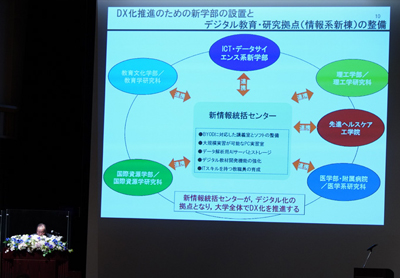
After mentioning the current organization of the university consisting of 4 faculties and 5 graduate schools, he introduced their initiatives on digitization including the Smart Mining Special Program as an inter-university exchange project in Faculty of International Resource Sciences, and online medical care that connects urban areas and remote rural areas by digitization of medical care at the Faculty of Medicine and University Hospital, and development of the walking environment simulator using VR technology in the Graduate School of Advanced Healthcare Engineering. In addition, as part of the future promotion of DX, he talked about the overview of “the new faculty related to ICT and data science” aimed to open as the fifth faculty in April 2024, the outline of "the type of human resources to educate", and the educational contents of 4 characteristic programs to be established there including information science as the core, human support, social safety, and business. Moreover, he outlined the facility and role of the Information Integration Center, for which a new building is under construction as a base for promoting DX across the whole university towards Society 5.0. Along with this, he also mentioned development of teaching materials for VR under planning and invitation of external lecturers.
FORUM8 Executive Officer, System Sales Manager
Lecture
After mentioning the idea of linking FORUM8's design support solutions for national resilience over diverse fields with the digital twins and utilizing them for the projects of smart cities and national resilience, he outlined external evaluations of integrated initiatives based on its VR platform. At the same time, he explained the overall process flow of UC-win/Road and how to utilize open data such as MLIT Data Platform and PLATEAU (both from Ministry of Land, Infrastructure, Transport and Tourism <MLIT>) as well as the point cloud data of local governments, using demonstration.
Additionally, he introduced use cases of various simulators and F8VPS in recent years, mentioning various possibilities to be brought about by utilizing infrastructure digital database systems, adoption of F8VPS by Ministry of Economy, Trade, and Industry for the Next generation software platform verification project, support for accounting and integration, functions enhancement of UC-win/Road, and proposals for AR/MR solutions and so on.
Group leader of FORUM8 Analysis support Group
Lecture
At the beginning, he summarized the positioning of FEM analysis solution series in FORUM8's product lineup. Then, regarding Geotechnical analysis series including 1) Three Dimensional Plate Dynamic Nonlinear Analysis, “Engineer’s Studio®”, 2) FEMLEEG Comprehensive finite element method analysis system, 3) 2D non-linear dynamic analysis/static analysis of reinforced concrete, “WCOMD Studio”, and 4) 2D Static Elastoplastic geotechnical analysis “Geotechnical FEM Geo Engineer’s Studio” and others, he explained with use cases such as 1) bridges (concrete bridges), 2) bridge superstructure (non-composite plate girder bridge), 3) analysis considering deterioration, 4) utilization of seismic observation / measurement values, 5) wooden buildings, 6) circular RC tank structures, and 7) steady and unsteady state analysis of heat conduction, etc.
FORUM8 Executive Officer, UC-1 Development Manager
Lecture
At the end of the first half of the afternoon, a presentation was made entitled “UC-1 Design Software Series to Improve Work Efficiency and Future Development”, focusing on the UC-1 Design Software Series, which is the core product group of FORUM8 Solutions “Design”. The speaker outlined the diverse product lineup according to the positioning of the series and linkage with other software products, features, functions and fields (Structural analysis/ cross-section, bridge superstructure, bridge substructure, foundation, temporary work, road work, sewerage and stormwater, geotechnical analysis/geotechnical improvement, CAD/CIM, and maintenance). Among them, multiple products are used to explain the linkage with other software products, effects from it, support for BIM / CIM, creation of design calculation sheets and drawings, and 3D parametric tools with demonstrations. While mentioning the features of UC-1 Cloud Automatic Design Series and its current lineup (BOX Culvert, Retaining wall, and Temporary sheathing work), the future plan of product release, support for automatic calculation for further improvement in design work efficiency, strengthening its linkage with UC-1 Engineer's Suite series, and support for AI support systems for determining degree of damage of bridges, the speaker also introduced how to operate Cloud with demonstration. Furthermore, he also mentioned the functions of and support for the latest version of the main product "BOX culvert design 3D bar arrangement", as well as future development plans.

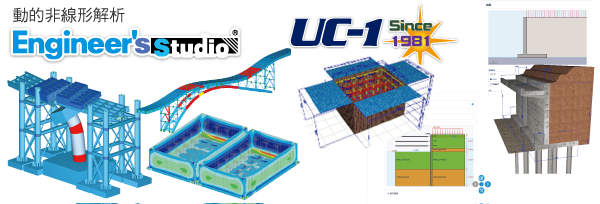

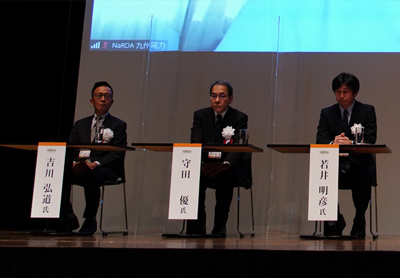
Judges (from the left): Prof. Hiromichi Yoshikawa, Prof. Masaru Morita, Prof. Akihiko Wakai
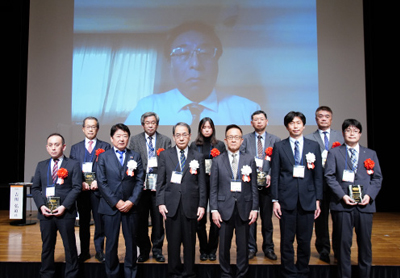
Award winners
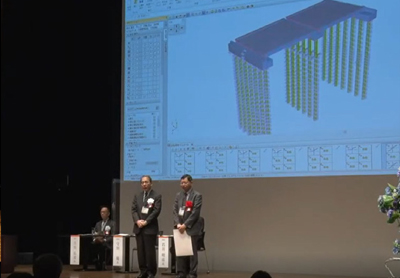
Comments from the juries
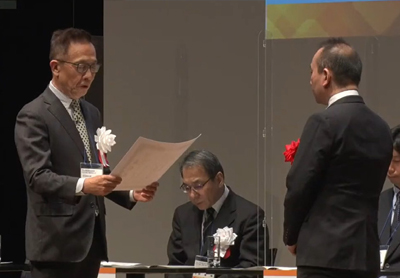
Giving certificates

Mr. Ryota Ieiri, moderator
In the second half of the day3 afternoon, awards of “the 8th National Resilience Design Award (NaRDA)” were announced and the awards ceremony was held. NaRDA honors initiatives that contribute to national resilience in the fields of structural analysis, ground and water engineering, and disaster prevention. Eight works were nominated on October 26 from among the works applied during the period from June 22 to October 15. On November 16, the Award-Winning Selection meeting was held at Forum8 Tokyo Head Office by three members: Hiromichi Yoshikawa, Jury Chair and Honorary Professor, Tokyo City University, Masaru Morita, Jury and Honorary Professor, Shibaura Institute of Technology, and Akihiko Wakai, Jury and Professor, Graduate School of Science and Technology, Gunma University. Awards were determined there.
As a result, the Grand Prix was won by NiX Co,. Ltd. for “Seismic Study of Existing Steel Pipe Arch Water Pipe Bridge –Check damages of steel arch members and verify nonlinear seismic performance of legs”. In this work, seismic diagnosis survey for the water pipe bridge of Langer stiffening type is made in conformity with the Seismic Design and Construction Guidelines for Water Supply Facilities. Nonlinear dynamic analysis is made to verify the earthquake resistance and comparison is made for the reinforcement methods for areas where resistance is insufficient. Seismic design of existing structures, which currently have many needs, was investigated and examined with reinforcement methods in a full span. Prof Yoshikawa evaluated that it was a big point to make the work for the viewers to understand the advanced process easily.
The Excellence Award went to “United Seismic Performance Verification of Civil Engineering Facility and Architectural Facility - Reproduce behaviors during earthquakes using dynamic analysis-" by F-tech Inc. In a large-scale drainage pump stations that integrates a large underground water storage tank and a multi-story building facility above ground, an integrated analytical model of them is constructed. A method for verifying seismic performance by dynamic analysis by giving actual seismic motion waveforms as external forces is proposed. Prof. Morita evaluated the work as a significant design in that in addition to the new challenge of seismic-performance inspection that integrates the upper and lower structures of construction and civil engineering with different standards, and that a very detailed optimal solution is examined.
Honorable Judge Award Structural Performance Evaluation Award (Prof. Yoshikawa) was won by "Study on Bearing Capacity of RC Beam Members Using Nonlinear Structural Analysis Program - Beyond the boundary of civil engineering and architecture-" by Knowledge Fusion Co., Ltd. Honorable Judge Award Bridge Pier Reinforcement Award (Prof. Morita) was awarded to “Level 2 Seismic Performance Verification for the Pile-Bent Piers –Study of seismic performance of the entire bridge by dynamic nonlinear analysis-” by SANKYO ENGINEERING Co., Ltd. Honorable Judge Award Urban Amenity Design Award (Prof. Wakai) went to "Three-Dimensional Dynamic Nonlinear Analysis of a New Five-Span Continuous Steel Pedestrian Deck Bridge –Compact structural investigation under limited space conditions-" by SEED CONSULTANT, INC. After each award was presented and awarded respectively by each judge, Prof. Yoshikawa, Jury Chair stressed the importance of accumulating concrete examples of analysis and design that contribute to national resilience for the next NaRDA. At that time, he summarized that it would be lead to high score to summarize "very complicated parts" in an easy-to-understand manner and to make it roughly understandable with the title and subtitle. All sessions have ended.